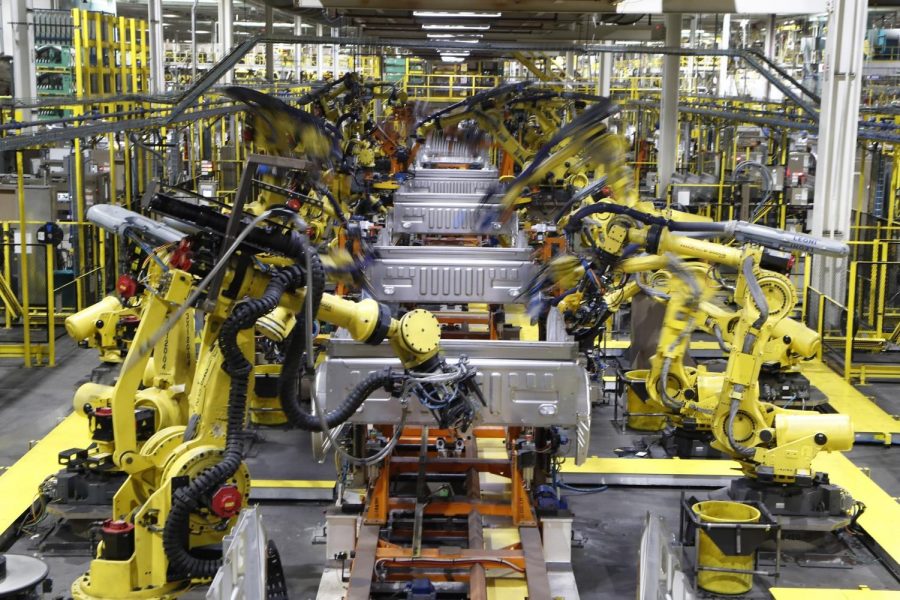Opinion: How COVID-19 will automate America’s economy
In this Sept. 27, 2018, file photo robots weld the bed of a 2018 Ford F-150 truck on the assembly line at the Ford Rouge assembly plant in Dearborn, Mich. U.S. businesses are edging their way toward figuring out how to bring their employees back to work amid the coronavirus pandemic, a transition that some say will result in increased automation. (AP Photo/Carlos Osorio, File)
April 30, 2020
Since 2010, the United States had seen 10 straight years of job gains as employment opportunities continuously emerged. But a decade worth of gains has been wiped away in less than one month, since the rapid spread of COVID-19 has ravaged the United States and the rest of the world.
With more than 22 million Americans out of work now, nearly all sectors of the economy have been negatively impacted. The government has begun sending eligible Americans $1,200 economic stimulus checks and unlocking federal grant and stimulus packages to help control damage dealt by the virus to small businesses and corporations.
As we continue to live in a “socially distant” nation and attempt to cautiously navigate these previously uncharted waters, it is hard to picture what the American economy may look like in a post-pandemic state.
But in all likelihood, many industries and businesses will look a lot more chrome (a dated reference to what people use to think the future would look like). America’s blue collar workforce was already on track to automate many positions before this pandemic.
COVID-19 will likely speed up the process of automation in a way that will change the way we do business forever.
It makes sense from a business standpoint to adopt an automated model if the cost of labor is minimized and the profit margin remains the same (or increases). In 2017, a report by McKinsey Global Institute revealed that as much as 30% of work done globally could be automated.
That number increases with the overall wealth of the nation, and the United States is among the richest countries on Earth. That same report suggested that 375 million members of the global workforce could end up switching jobs or learning new skills as a result of intelligent automation.
Of course, physical labor and non-skilled jobs are destined to be the first to go. One particularly vulnerable sector in the United States is the fast food industry, which as of 2018 employed around 3.7 million people. Prior to COVID-19, automation across many sectors like fast food was viewed as a long-term goal to cut labor costs, expand profit and modernize industries as technology plays a larger role in the economy.
But following the mass amounts of revenue losses and financial instability that will rock nearly all sectors in the U.S after the pandemic, automation may become necessary in the eyes of many.
With COVID-19 limiting human interaction, many businesses have been forced to commit massive layoffs and furloughs. With reduced revenue streams, salaries and wages become much larger percentages of total expenses.
But even in times of normalcy, employees are expensive to employ. Typically, a company can spend between 40 – 80% of its gross revenues toward employee salaries and benefits.
Companies such as Starbucks that offer extensive benefit programs pay even more. And considering that Starbucks is not allowing any customers in their stores and many non-drive thru locations are closed altogether, employee costs are likely causing more stress than ever on companies in similar situations.
Turning to automation in an attempt to reduce those employee costs and gradually rebuild revenue steams will likely be the direction that companies such as Starbucks will follow. And with Starbucks already having developed a fully-functioning kiosk capable of brewing hot and iced coffee, signature lattes and more, the transition will occur fairly quickly.
Following the mass amounts of revenue loss during COVID-19, businesses will have to find new ways to reduce expenses and regain business.
Entities outside of the originally predicted sectors will also look at ways to automate their services or the people that provide them.
For example, gyms like OrangeTheory and Planet Fitness have started offering virtual workouts to their subscribers during quarantine. Fitness coaches are featured in the videos as they are essential to instruction and training for their members, but desk managers and attendants are not necessary to keep on hand at this time. Even when gyms return to normality, it may deem cost effective over the long term to transition account management and member services to automated services.
Overall, companies will look at methods of cost reduction to help make up for losses suffered during COVID-19, and these cuts will likely extend across many sectors after the pandemic is over.
People may reject the idea of mass automation coming to America’s workforce by citing moral objections which would keep consumers from spending money at businesses embracing worker automation.
But would this be the case if the quality of the company’s product remained the same (or potentially increased), efficiency increased and the costs of the products declined?
According to Avomeen Analytical Services, there are five attributes that customers look for when purchasing a product: Quality, Marketing Claims, Innovation, Safety and Competitor Comparison.
What if a Starbucks kiosk could make the consumer a fresh, delicious cup of coffee in under under seconds and for ¾ the costs of a competing coffee shop down the street? The company markets that quality and speed, and ensures that the product is entirely safe.
Sure, some consumers would reject it, but considering the quality was high, the cost was low, the speed made it innovative, its regarded as food safe and it beats its competitors in time served and consumer costs, it would probably attract the average buyer.
Consumers should prepare for the upcoming changes related to labor and the impact of AI on the economy.
Prior to the COVID-19 pandemic, over 80% of enterprises were already investing in artificial intelligence in the workplace, with 30% indicating a plan to increase funding in coming months.
Companies have already begun planning for an automated takeover, and now its time for us to brace for the impact.
Further investment into technology will increase the average quality of products and services across the board, while ultimately lowering consumer costs due to the cost saving associated with cutting human labor.
And for individuals who have had their jobs absorbed by automation, the future may be exciting. Currently, governments across the world like many of the Nordic nations and Canada, which are leading developers for A.I, have already begun testing Universal Basic Income for citizens.
This could be one possible way of dealing with the mass amounts of unemployment that will occur from the absorption of human jobs. And with COVID-19 prompting many governments to offer or expand government issued income supplements, a universal income has started to look more possible.
Opportunities like UBI could allow for people who once worked back-breaking, low wage jobs to reinvent themselves, improve their health and enjoy more leisure.
While we continue to swim in uncharted waters when it comes to Coronavirus and the impact that it will ultimately have on the economy, we should brace for our workforce to look much different following this pandemic than it did when we entered it.
An automated workforce is on its way.







